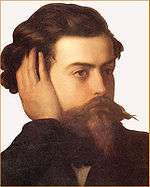Goffredo Mameli

Goffredo Mameli (Italian pronunciation: [ɡofˈfreːdo maˈmɛːli]; Genoa, 5 September 1827 – Rome, 6 July 1849), an Italian patriot, poet, and writer was a notable figure in the Italian Risorgimento. He is also the author of the lyrics of Il Canto degli Italiani, the national anthem.
Biography
The son of an aristocratic Sardinian admiral, Mameli was born in Genoa where his father was in command of the fleet of the kingdom of Sardinia. At the age of seven he was sent to Sardinia, to his grandfather's, to escape the risk of cholera, but soon came back to Genoa to complete his studies.
The achievements of Mameli's very short life are concentrated in only two years, during which time he played major parts in insurrectional movements and the Risorgimento.
In 1847 Mameli joined the Società Entelema, a cultural movement that soon would have turned to a political movement, and here he became interested in the theories of Giuseppe Mazzini.
Mameli is mostly known as the author of the lyrics of the Italian national anthem, Il Canto degli Italiani (music by Michele Novaro), better known in Italy as Inno di Mameli (Mameli's Hymn). These lyrics were used for the first time in November 1847, celebrating King Charles Albert of Sardinia in his visit to Genoa after his first reforms. Mameli's lyrics to a "hymn of the people" —"Suona la tromba"— were set by Giuseppe Verdi the following year.

Mameli was deeply involved in nationalist movements and some more "spectacular" actions are remembered, such as his exposition of the Tricolore (current Italian flag, then prohibited) to celebrate the expulsion of Austrians in 1846. Yet, he was with Nino Bixio (Garibaldi's later major supporter and friend) in a committee for public health, already on a clear Mazzinian position. In March 1848, hearing of the insurrection in Milan, Mameli organised an expedition with 300 other patriots, joined Bixio's troops that were already on site, and entered the town. He was then admitted to Garibaldi's irregular army (really the volunteer brigade of general Torres), as a captain, and met Mazzini.

Back in Genoa, he worked more on a literary side, wrote several hymns and other compositions, he became the director of the newspaper Diario del Popolo ("People's Daily"), and promoted a press campaign for a war against Austria. In December 1848 Mameli reached Rome, where Pellegrino Rossi had been murdered, helping in the clandestine works for declaration (9 February 1849) of the Roman Republic. Mameli then went to Florence where he proposed the creation of a common state between Tuscany and Latium.
In April 1849 he was again in Genoa, with Bixio, where a popular insurrection was strongly opposed by General Alberto La Marmora. Mameli soon left again for Rome, where the French had come to support the Papacy (Pope Pius IX had actually escaped from the town) and took active part in the combat.
Death
In June, Mameli was accidentally injured in his left leg by the bayonet of one of his comrades. The wound was not serious, but an infection took hold, and after a time the leg had to be amputated. Mameli died of the infection on 6 July, about two months before his 22nd birthday.
See also
Notes
- ↑ The original Italian text:
"E lira e spada staranno giusto simbolo della sua vita sulla pietra che un dì gli ergeremo in Roma nel camposanto dei Martiri della Nazione" ("Both lyre and sword will remain, as the fair symbol of his life, on the stone we will raise in his honor one day in the cemetery of the Nation's Martyrs in Rome") — Giuseppe Mazzini
References
- Barrili, Anton Giulio (1902). Scritti editi ed inediti di G. Mameli. Genoa: Soc.Ligure di Storia Patria.
- Anton Giulio Barrili (1 June 1902). "G. Mameli nella vita e nell'arte". Nuova Antologia.
External links
| Wikisource has original works written by or about: Goffredo Mameli |